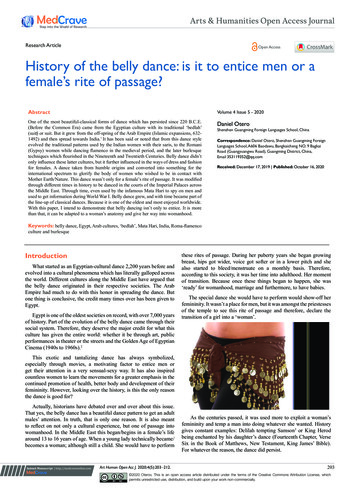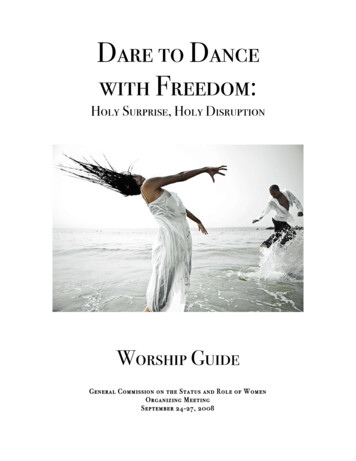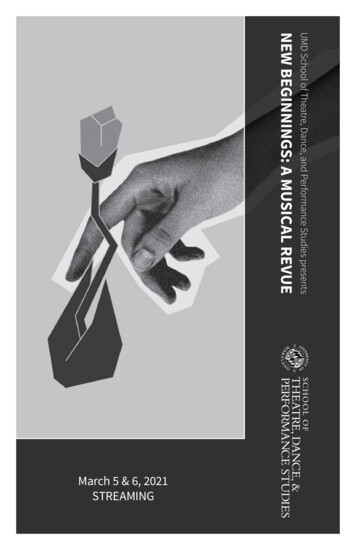
Transcription
Arts & Humanities Open Access JournalResearch ArticleOpen AccessHistory of the belly dance: is it to entice men or afemale’s rite of passage?AbstractVolume 4 Issue 5 - 2020One of the most beautiful-classical forms of dance which has persisted since 220 B.C.E.(Before the Common Era) came from the Egyptian culture with its traditional ‘bedlah’(suit ) or suit. But it grew from the off-spring of the Arab Empire (Islamic expansions, 6321492) and then spread towards India.1 It has been said or noted that from this dance styleevolved the traditional patterns used by the Indian women with their saris, to the Romani(Gypsy) women while dancing flamenco in the medieval period, and the later burlesquetechniques which flourished in the Nineteenth and Twentieth Centuries. Belly dance didn’tonly influence these latter cultures, but it further influenced in the ways of dress and fashionfor females. A dance taken from humble origins and converted into something for theinternational spectrum to glorify the body of women who wished to be in contact withMother Earth/Nature. This dance wasn’t only for a female’s rite of passage. It was modifiedthrough different times in history to be danced in the courts of the Imperial Palaces acrossthe Middle East. Through time, even used by the infamous Mata Hari to spy on men andused to get information during World War I. Belly dance grew, and with time became part ofthe line-up of classical dances. Because it is one of the oldest and most enjoyed worldwide.With this paper, I intend to demonstrate that belly dancing isn’t only to entice. It is morethan that, it can be adapted to a woman’s anatomy and give her way into womanhood.Daniel OteroShenzhen Guangming Foreign Languages School, ChinaCorrespondence: Daniel Otero, Shenzhen Guangming ForeignLanguages School, A606 Baodawu, Bangkaicheng NO. 9 BagkaiRoad (Guangyuangwu Road), Guangming District, China,EmailReceived: December 17, 2019 Published: October 16, 2020Keywords: belly dance, Egypt, Arab cultures, ‘bedlah’, Mata Hari, India, Roma-flamencoculture and burlesqueIntroductionWhat started as an Egyptian-cultural dance 2,200 years before andevolved into a cultural phenomena which has literally galloped acrossthe world. Different cultures along the Middle East have argued thatthe belly dance originated in their respective societies. The ArabEmpire had much to do with this honor in spreading the dance. Butone thing is conclusive, the credit many times over has been given toEgypt.Egypt is one of the oldest societies on record, with over 7,000 yearsof history. Part of the evolution of the belly dance came through theirsocial system. Therefore, they deserve the major credit for what thisculture has given the entire world: whether it be through art, publicperformances in theater or the streets and the Golden Age of EgyptianCinema (1940s to 1960s).2these rites of passage. During her puberty years she began growingbreast, hips got wider, voice got softer or in a lower pitch and shealso started to bleed/menstruate on a monthly basis. Therefore,according to this society, it was her time into adulthood. Her momentof transition. Because once these things began to happen, she was‘ready’ for womanhood, marriage and furthermore, to have babies.The special dance she would have to perform would show-off herfemininity. It wasn’t a place for men, but it was amongst the priestessesof the temple to see this rite of passage and therefore, declare thetransition of a girl into a ‘woman’.This exotic and tantalizing dance has always symbolized,especially through movies, a motivating factor to entice men orget their attention in a very sensual-sexy way. It has also inspiredcountless women to learn the movements for a greater emphasis in thecontinued promotion of health, better body and development of theirfemininity. However, looking over the history, is this the only reasonthe dance is good for?Actually, historians have debated over and over about this issue.That yes, the belly dance has a beautiful dance pattern to get an adultmales’ attention. In truth, that is only one reason. It is also meantto reflect on not only a cultural experience, but one of passage intowomanhood. In the Middle East this began/begins in a female’s lifearound 13 to 16 years of age. When a young lady technically became/becomes a woman; although still a child. She would have to performSubmit Manuscript http://medcraveonline.comArt Human Open Acc J. 2020;4(5):203‒212.As the centuries passed, it was used more to exploit a woman’sfemininity and temp a man into doing whatever she wanted. Historygives constant examples: Delilah tempting Samson3 or King Herodbeing enchanted by his daughter’s dance (Fourteenth Chapter, VerseSix in the Book of Matthews, New Testament, King James’ Bible).For whatever the reason, the dance did persist.203 2020 Oterov. This is an open access article distributed under the terms of the Creative Commons Attribution License, whichpermits unrestricted use, distribution, and build upon your work non-commercially.
Copyright: 2020 OteroHistory of the belly dance: is it to entice men or a female’s rite of passage?Therefore, the idea of the classical-belly dance has turned into thatkind of phenomena and I quote a female, “I do more the belly dance toattract men!” Given that this is the most common perception on whywomen still perform this particular dance.The reasons here are not to judge, but to give this classical dancean exposure which isn’t only sexual; moreover, one which is cultural.However, let me be perfectly honest. Belly dancing was madeinvented to adapt to a woman’s body. In this art form, the center pieceof the entire dance were/are the hips and belly area. The latter usuallywas the main focal point or as shown in the image below these lines.Other forms of the dance or dance techniques use the following: arms,legs and head movements.204influence parts of the flamenco-dance style in the following way: howthe music is played, people do a roundabout motion with their hips,perform the traditional turns and certain costume elements, etc.This phenomena made a cultural impact around the world.As European explorers by the end of the Fifteenth and SixteenthCenturies set for the ‘New World’, the dance would spread throughthe Americas--becoming popular in every way.However, one thing which has held back the belly-dance craze.This dancing style hasn’t been like: flamenco (said to have evolvedfrom the belly dance itself), ballet, waltz, tango, salsa, mambo orcha-cha.4,5 All these previous styles have adapted to both sexes, maleand female. With the belly dance, it has adapted for the most part towomen. Making it harder for men to become part of it. And still, menare joining the ranks of this sensual dance; whether it is for culture,learn to dance or stay in shape. The prejudices of Western society inthe last 30 years towards the Middle East or anything Arab has alsoaffected its growth in parts of North America and Europe.Experts have argued that the dance needs to be expanded to adaptto the male population. Yes and maybe so, however, when this dancewas created, it was made for the sole purpose to adapt to a woman’sphysic, her femininity, her own sensuality and be transported on herown into the rights of womanhood.Take your pick, whether it is only for women or for women toentice men. What this investigative paper tends to prove that it wasinvented by women to be enjoyed on their terms; nothing more andnothing less.MethodologyImage by amazon.comYes, there are different styles and techniques when travellingthrough the Middle East. The main styles come from Egypt, Turkeyand Lebanon. But other styles exude throughout these lands; whethera person is in Morocco, Israel, Greece or as to the far east of Iran.What this study tries to prove that it isn’t focused entirely onthe sexual context. It is also to study why this dance adapted to awoman’s body and her rites of passage. Why does it continue to growin popularity? Furthermore, this dance is not to be taken in a negativelight. It is to bring this art form from out of the literal ‘dark ages’ intoview for the entire world to see and enjoy.In contemporary times, the belly dance is practiced in 15 to 22or so countries of the Middle East. Unless it is an ultra-conservativeMuslim society, in which the dance isn’t practiced or it is practiced insecrecy. But for the most part, this dance is tolerated in most cultures.It was never meant or created to leer [the belly dance]. It wasmeant to be enjoyed by generations of women. Furthermore, it wasmeant to also be enjoyed in a natural setting by men.With the above statement in mind, the popularity of the belly dancedoesn’t seem to wane after 22 centuries. Reaching India, to the farof corners of China, South Korea and Japan; influencing the furthestcountries from the Middle East and Northern Africa. Through thelast-two millennium it expanded or grew. Going into Europe. Possiblytransported by the Arab-culture itself through the subsequent invasionsof Europe during the Middle Ages or the Romani (Gypsy) people whotook it via India and introduced it to Spain. The belly dance evolvedfrom the traditional strumming and rhythms from the Middle East toBelly dancing wasn’t even on my mind till recently when I wastransferred and began working in Shenzhen, Guangdong, China. Mydesire was to get into shape, back into the motion of exercise and life,after a hiatus of eight years. With the challenges of being overweight,I stumbled onto different classes as I joined the local gymnasium inGuangming District. It was almost by mistake. I began to enjoy mylife again and do exercise classes, such as: aerobics, an-aerobics, yoga& Pilates.But with a wonderful variety of classes and teachers, I began torefocus my life in the area of dancing. This was when one Fridayevening in November, 2019, I went on to experiment for the first timein my life a belly-dance class. The experience to be quite honest leftme positively impacted. Wanting something more. It was wonderfuland at the same time, I was worried, since I was the only male inthe class. Afraid of invading these females’ precious-personal space.Most males would be honored [and I was] to be amongst this ‘harem’of beautiful ladies. However, that was not my purpose, it was out ofsheer desperation to get my health back again and socialize.I had experienced belly dancing, but only as an spectator. A manwhom had seen live shows through the Americas, Europe, the MiddleEast, Africa and East Asia. Other inspirations about belly dancingwere from Coco Lee’s 2005 hit song, “Belly Dance”.6One night, I simply decided to do research on everything I couldlearn about belly dancing. I soon discovered much about this ancientdance and its rituals. Learning in the process that, here is one of theoldest dances recorded in world history. Here was my inspiration tostart writing an article for the futurehandling.com website in HongKong and another was this investigative piece.7Citation: Otero D. History of the belly dance: is it to entice men or a female’s rite of passage? Art Human Open Acc J. 2020;4(5):203‒212.DOI: 10.15406/ahoaj.2020.04.00171
Copyright: 2020 OteroHistory of the belly dance: is it to entice men or a female’s rite of passage?205During that first week after the belly-dance class, I thought aboutthe topic and wrote a little over 700 words into an article. I had neverwritten about this theme till now. Placing my idea, or call it myhistorical-opinion about the issue onto paper. This was one topic I hadnever touched base before and soon understood, that this dance wasn’tonly for women, but also for men. Inside a period of 50 minutes: itwas good to sweat-off the kilos, exercise and tone the body. I found itto be good fun, while learning new movements!However, it is not to say that this investigation doesn’t have flaws.Most of the times, it is my intention to remain objective; however,there are times in which I may fall into subjectivity. For this reason,I apologize ahead. With that in mind, please enjoy this investigation,‘History of the Belly Dance: Is it to entice men or a female’s rite ofpassage?’ Kind regards.From my second experience in the class, it was a sheer pleasureto learn from the teacher and these wonderful ladies. Personally, Ifelt accepted and they gathered around me in a warm welcome. Afterall, I was the first and only male to try the class. Furthermore, this artwas something perfectly new to me. Soon, other males would join theranks in the ever expanding-class crowd.History has told the belly dance began 2,200 years ago. However,that is the documented version on the manuscripts since Ancient Egyptwas ruled by the pharaohs. Then historians began taking a closer lookat the facts and how this ancient-classical dance form grew. How itextended from the Egyptian coast across Northern Africa; as a matterof fact, this dance method went east and west with commercialexchange. It reached into Northern India. It was extremely influentialin such a way that it crisscrossed back into Southern Europe andreaching into Spain with the Romani (Gypsy) culture.I went home with even more infused passion and decided to searchfurther into the topic. With that said, I decided to do research on bellydancing and prove a point. Belly dance wasn’t or isn’t only to conquera man’s heart: it was for people to have fun, exercise and females havetheir own unique experience. It is also a dance which can easily openup to men if they are willing to leave out all the machismo attitudesoutside this space. However, there is one truth, I decided to write onthis particular theme to not only prove that it is for a woman’s rite ofpassage. It is for people to come together and enjoy.Further, it is also to dispel certain myths about the art. A majorityof women admitted they learned this dance style to attract men ortheir husbands/boyfriends, etc. But it wasn’t for men to come along,howl ‘at the moon’, whistle, throw obscenities and leer at them. Thiswas the last thing on their minds or what they wanted! Because fordecades, after belly dancing made its way into Western society, itwas negatively introduced into the stripper-club way of life and stag[bachelor] parties. Therefore, for many practicing this cultural styleof dance wanted to demonstrate the following: that it is a beautiful artnot to be tarnished or to be made into something cheap. This art couldbe sensual, cultural at the same time and with something which in fullview it is meant to be admired.This investigative paper through analysis intends to expose thetruth [as much as possible] and show for what the belly dance trulyis, a dance adapted for women. Furthermore, it is to be enjoyed ina setting which is clearly for their rites of passage: from a girl to awoman and so forth. This paper also tries to literally ‘drill’ at the topicrespectfully and carefully. For this is my unique chance to show aworld which few know about and bring to light an art that is almostobscure with ignorance in a certain way. This is not to say that mencannot participate. They [men/males] can, but do it with admirationand in a respectful way! Belly dance after all is cultural and somethingwhich all should be able to enjoy!Through this investigative paper, what I also intend to show is thefollowing: its origins, intro into Western society, what it went throughafter the 1990s and where is belly dance today?Especially after 1991, when the desire for anything Arabic orMiddle Eastern literally ‘soured’ after the Desert Storm and DesertShield wars took place.8,9It is in a way to bring back what is good and classical about theMiddle Eastern background--without the prejudices and racism of warwhich have befallen in our contemporary times.Now, this is the methodology which I intend to follow: to exposefurther the topic, bring it to light and hopefully for a new generationof people to enjoy the dance worldwide.HistoryTherefore, the history of this dance goes back further than its 22centuries prior. Historians have argued countless times that this danceis more in the range of 6,000 years.10With its initial beginnings in the holy-female temples throughoutEgypt; women priestesses prepared a ceremony for young femaleswhen they reached the age of puberty. This ceremonious act was oneto bring females into womanhood, with the rites of marriage andprayers for fertility, etc.This dance began as a form of adoration and in a pagan ritual toa female deity. The dance itself had a deeper meaning than it wasoriginally intended, since it came originally from a matriarchal-tribalway of life. It was a dance ritual preparing the woman’s body to getpregnant and during pregnancy. This method consisted of movementsto help improve the health of the female and assist her with ease whengiving birth. However, nothing of the latter stated has been proven,just passed down in theory--according to the science and ancientsocial practices.11-14The women gathered to dance together during social events. Alsoto prepare a female whom made it to puberty for marriage and duringthe marriage rituals before she met her groom.But the dance’s (belly dance) true exposure worldwide was whenit was shown in French society. Initially the French called it, ‘Ladanse du ventre’ and voila, we have in translation--‘the dance of thestomach’ or how it is commonly known today as ‘Belly Dance’. Whenit was demonstrated in the Chicago World’s Fair of 1893 (World’sColumbian Exposition), it certainly caused a commotion. Those whowitnessed this hypnotic dance called it mistakenly so, the ‘Dance ofthe Orient’.The problem that once it was exposed to Western society, it wasoften and in a stereotypical way portrayed as a dance to entice forsexual purposes only. Therefore, from something spiritual in nature,in later years it was often associated with something negatively forstriptease, burlesque (however, belly dance did influence burlesqueand not the other way around) or used by strippers; which in truth, hadnothing to do with it.15The correct concept or term for this dance is, ‘Dance of the East’,referring to the Arabic term of ‘Raqs sharki’ (Eastern Dance) (1800sto the 1930s) ‘Dance of the Orient’ was the incorrect term given tothe dance. If people refer to the belly dance as a dance of the orient,it would be more in line with countries like: China, Korea or Japan.Citation: Otero D. History of the belly dance: is it to entice men or a female’s rite of passage? Art Human Open Acc J. 2020;4(5):203‒212.DOI: 10.15406/ahoaj.2020.04.00171
Copyright: 2020 OteroHistory of the belly dance: is it to entice men or a female’s rite of passage?A. Was this dance only for women?206C. The belly dance has two mainstreamsPossibly it was, as time evolved and society transformed itself,men came to belong as a part of this unique dance troupe. It wasespecially noticeable throughout the streets of Cairo, Egypt, whenwomen and men performed together.The dance itself has two mainstreams. One is from Egypt andthe other from Turkey, with different variations and not only MiddleEastern in influence. Belly dancing has adapted to Western, African,European and Asian techniques.Later, as European empires emerged, the French and British beganto exert their power over Egypt, this changed radically. European menpreferred to see only female-solo acts. This was the dramatic changewhich occurred into the Nineteenth Century.But the two most important always resound with Turkey andEgypt:The dance itself went through an evolution: which started withwomen, afterward men were later allowed to join in and then menwere banned from the dance troupes for female-only dancers.a. TurkeyThe dance style in Istanbul since medieval times was heavilyinfluenced by articulate movements of the hips and torso. Wheremany dancers use more finger cymbals and veils.16With the European influence and once this dance crossed over theAtlantic Ocean into the New World, this movement had an entirelydifferent connotation. It was considered in sexual nature to provokemen into an intimate encounter. Therefore, from this point it wasgiven a negative stereotype and later in history, the belly dance wasassociated more with the ‘exotic Mata Hari’ types.B. Who was ‘Mata Hari’?Mata Hari (from the Malay, its translation means ‘eye of the day’or ‘to captivate’) was a Dutch-born entertainer (Margaretha Zelle)who slept with men for financial gain. She was an extremely famousburlesque dancer in Paris, France at the beginning of the 20th Century;who had gorgeous exotic-dark looks. She used her different belly andHindu techniques during her dance shows. She was especially famousfor her ‘temple dance’. As her popularity waned by 1915, at the dawnof World War I, because of her age and men having the preference foryounger dancers--she later became a spy. Many historians assert thatshe became an Agent for the French Intelligence Services; however,she later ‘turned’ and became a Double Agent for the German-HighCommand during the War. Already 40-years old, she fell in love witha young-Russian officer (Vladimir de Massloff) and this has beenoverly stated as her main motivation for making money as a DoubleAgent. When she was caught in 1917, she was swiftly put on trial andas soon as she was found guilty, promptly executed! Possibly beingused as a ‘scapegoat’ by the French for their loses during WWI. Nodefinite proof as ever been presented if she had ‘turned/become adouble agent’ or not!Not to blame everything on the poor Mata Hari, but it has been saidbecause of her--she gave the belly and Hindu styles a bad reputation(the dance being called, ‘obscene’). However, this is only half thetruth, the reality was, these dances were already made sexual in natureonce they reached Europe and America.Image from ancientartstudios.comb. EgyptStreet performers who danced around Cairo, Egypt were knownas ‘ghawazi’ (Return to the invader). Their methods were moretraditional than the Turkish rituals. Not only did these dancersperform their shows on the streets; the troupe had a male and femaleensemble. It was a common sight in coffee houses and during publicfestivals, etc. Few times did the Egyptian style depend on props orother ornaments. To give the show intensity, sometimes a cane orsword was incorporated into the act.17 The dancer was acknowledgedmore for his/her technique and the costume used. By the twentiethcentury, the Arabic word ‘Baladi’ (My country) was incorporated intothe belly dance world. This meaning it was a dance and costume usedby the country [Egypt] in its folklore.Image from the Smithsonian Magazine (Bibliotheque nationale deFrance).Citation: Otero D. History of the belly dance: is it to entice men or a female’s rite of passage? Art Human Open Acc J. 2020;4(5):203‒212.DOI: 10.15406/ahoaj.2020.04.00171
Copyright: 2020 OteroHistory of the belly dance: is it to entice men or a female’s rite of passage?If comparing both dance styles, the movements of each exquisitelybeautiful in their own right. Obviously, the Egyptian-belly dance is farolder than the one from Turkey. The reasons for this is the following:as the Arab influence and empire spread across the Middle East, AsiaMinor, Northern Africa and Southern Europe--so did this dance.The Egyptian style took a stronger influence when nightclubs beganopening up during and after the 1920s.The Belly Dance world also has a third stream, one which focuseson both dances from Egypt and Turkey meshed in together.18 TheLebanese style of the belly dance (Raqs Sharki Lubnani) is one whichgoes perfectly with: backward movements of the torso [sometimesextreme], kicks, splits, strong shimmy in the motion of the hips [orwhole body], elongated big-golden skirts [sarongs] which flowoutward to give the dancer grace and poise.207(Venus). However, this cannot be completely confirmed. The fact is,the origins of the Greek-Tsifteteli came through a culture of crossroads.From the Turkish ‘Chifteteli’, meaning ‘two strings’: which one isfrom Turkey (country who colonized and occupied Greece for 400years) and the other from the Middle East. Women wear rhinestoneson their costumes and during performances dance in groups like ina discotheque.19 My earliest memories were as a young man in SanDiego, California seeing a performance of this style in a restaurantcalled, Greektown.20D. AftermathIt wasn’t without controversy the development of the belly danceworld; especially in conservative Egypt. For a society who didn’tallow women to expose their torso, even less the arms, hair or feet-by the 1950s, this culture went through a transformation. It beganwith dancers like ‘Little Egypt’ and doing intricate movements withher upper body. This made conservative-Egyptians very angry, butthe rest was history and the changes this dance brought to the restof the world. From the wearing of a corset to not expose the torso,to a dance which would show the torso completely and with exoticmovements which magnetized those who watched this unique-dancestyle.21 However, it was banned again after the 1950s and dancersweren’t allowed to show their belly according to the Muslim laws ofvirtue and respect. It remains the same till present-day.But this dance whether it is in the Egyptian or Turkish form alreadyhad caused controversy at the Chicago World’s Fair of 1893. One,because the free movement of the torso offended many conservativesand second, [not proven] that it nearly gave the essayist Mark Twaina heart attack.The height of the belly dance craze had had its time before, butnever like the years between the 1950s to the 1990s. When everythingMiddle Eastern was treasured, considered cultural and more exotic.Everybody wanted either an opportunity to learn the dance or in theirmajority, see the dance.Image by stylecraze.comWith the growth of the feminist movement in the 1960s, cameradical changes. That by the 1970s and 1980s America, belly dancecame to symbolize something uniquely different. It came to representnot only femininity. It became a symbol of pride amongst feminist tonot only showcase their bodies and consider themselves goddesses.This art form became one with empowerment. The belly dance worldwas connected to something more than that, people also went backto the source. Therefore, looking for spiritual meaning/connection inthe dance: from Mother Earth, to birth rite and marriage. Taking thisdance to a whole new level, one to make women feel equal to men.But nothing last forever and like every dawn, there is also a dusk!Image by FeminaIn the evolution of styles, other than the Lebanese dance--aGreek technique called the Tsifteteli was born. Method was possiblydeveloped in ancient times to worship of the Goddess AphroditeImage from arabesquebellydance.comCitation: Otero D. History of the belly dance: is it to entice men or a female’s rite of passage? Art Human Open Acc J. 2020;4(5):203‒212.DOI: 10.15406/ahoaj.2020.04.00171
Copyright: 2020 OteroHistory of the belly dance: is it to entice men or a female’s rite of passage?This changed completely after the First Persian Gulf War. By then,anything from the Middle East or anything which came from SaudiArabia was looked upon with suspicion and paranoia. Forgetting whata valuable legacy this dance had given the world with other equallyfamous classical dances.g. Samia Gamal in her own right was the best of the best. Hailedas the world’s greatest-belly dancer in her time. She was bornin 1924, Egypt. She studied initially ballet and modern dance,which quite possibly gave her the edge in belly dancing.Her unique style was especially attractive when she did her‘veil work’ during performances. Samia achieved not onlyinternational status in Egypt, but also in 1950s Hollywood.Films which are classics in the Hollywood-adventure/fantasygenre, ‘Ali Baba and the Forty Thieves’ (1954) and ‘Valleyof the Kings’ (1955). Gorgeous human being and wonderfuldancer, indeed.Into the 1990s and the beginning of the Twenty-first Century, sadlythis dance had [although classical] not even been inscribe as part ofthe UNESCO ICH (Intangible Cultural Heritage). This has been thecase since the early 1990s, because of strong prejudices of where thedance originated from; not viewing what this great art form has giventhe planet. Starting with its beginnings in Egypt and spreading out tothe entire globe. For those fans of the belly-dance world, they’ll haveto see what the future holds and hope it is brighter. Since this dancedeserves its incorporation into the ICH list as part of a classical breedof dances to influence the world entire through history. Time will onlytell.h. Naima Akef was part of the ‘Golden Age of Egyptian Cinema’.She won the Bolshoi Theater Prize in Moscow, Russia. Part ofa generation to perform in movies, theaters and productions.i.Fifi Abdou is one of the contemporaries after the ‘Golden Ageof Egyptian Cinema’. Born in Cairo, Egypt, April 26, 1953. Sheis a belly dancer and actress.j.Shakira, from Barranquilla, Colombia (b. 1977) is a singer withalbums in Spanish and English. An international-super starin her own right. And one of the things which has made hernotable for her work is her incorporation of the Lebanese-bellydance style into her performances. Shakira’s ancestry is fromLebanon and with her music fine tunes this dance into pieceslike, ‘Hips Don’t Lie’.Famous-female icons in the belly-dance worldThe list composed in this investigation deals with 10 of the world’sbest female-belly dancers. Some names came from the web, and moreoften than not, lists which stated repeatedly the same names over andover. But to gather this information, also there was a need to mix inpast performers with contemporary ones. There are great dancers outthere which should have been mentioned and I didn’t. For that, manyexcuses. These 10 have influenced the belly-dance culture around theworld and therefore, like a phoenix, made its rise to transcend spaceand time.i.k. Rachel Brice, responsible for fusing belly
Dec 17, 2019 · affected its growth in parts of North America and Europe. Experts have argued that the dance needs to be expanded to adapt to the male population. Yes and maybe so, however, when this dance was created, it was made for the sole purpose to adapt to a woman’s physic, her femininity, her own sensuality and be transported on her










